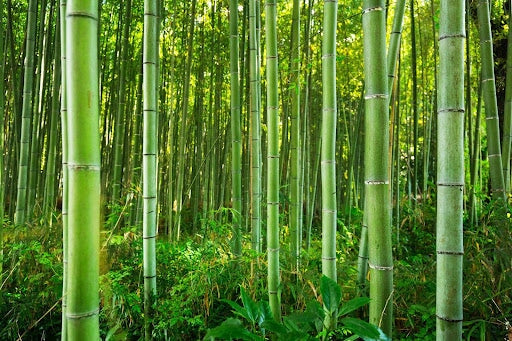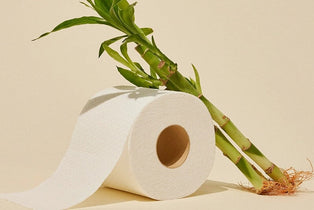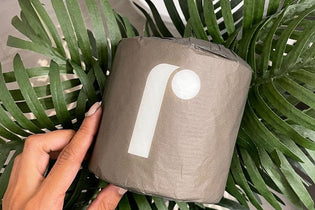
TLDR
Bamboo, a word that conjures images of serene Asian gardens and giant pandas munching on green shoots, has been a subject of botanical intrigue for ages.
This tall, sturdy plant, often mistaken for a tree, is actually grass. Yes, you heard that right – grass.
This surprising fact about bamboo raises several questions about its nature, usage, and importance in our ecosystem and daily lives. Let’s delve into the fascinating world of bamboo, from its classification in the plant kingdom to its role in sustainable development and products like Reel Paper’s bamboo toilet paper.
The Core of the Debate: Tree or Grass?
The confusion about bamboo’s classification stems from its towering presence and wood-like appearance. But, is bamboo a tree? Scientifically, no. Despite its impressive stature, bamboo belongs to the grass family. This revelation often comes as a surprise, considering its remarkable differences from the lawn grass we're familiar with. This distinction is crucial in various fields, from botany to agriculture, impacting how bamboo is cultivated, used, and even legislated around the world.
Understanding Bamboo's Biological Classification
Venturing into the realm of bamboo's biological classification reveals a fascinating world where common perceptions are challenged by scientific facts. Understanding where bamboo stands in the vast hierarchy of the plant kingdom not only enriches our knowledge but also reshapes our perspective on this versatile plant. The following are some of the scientific nuances that define bamboo, distinguishing it from its woody counterparts and elucidating its true identity as a remarkable member of the grass family.
Scientific Classification: Bamboo in the Plant Kingdom
Bamboo belongs to the subfamily Bambusoideae of the grass family Poaceae, which is the same family that includes everyday grasses. There are over 1,400 species of bamboo, growing in diverse environments from East Asia to South America. Some species, like the Moso bamboo, can tower high, resembling trees more than the typical grass. This variety of species underlines bamboo's versatility and adaptability, making it a plant of significant interest to both environmentalists and industrialists.
Defining Characteristics of Bamboo as a Grass
Unlike trees, bamboo has a hollow stem, or culm, and lacks the woody tissue typical in tree trunks. Bamboo’s root system, composed of rhizomes, is another characteristic that aligns it more closely with grasses. These rhizomes enable both running and clumping bamboo varieties to spread efficiently. Its unique anatomy sets bamboo apart from other woody plants, contributing to its resilience and rapid growth.
Bamboo vs. Trees: A Comparative Analysis
When comparing bamboo to trees, one notable difference is the growth pattern. Bamboo grows from its base and doesn't have secondary growth phases like trees. This unique growth mechanism allows certain bamboo species to be among the fastest-growing plants globally. Additionally, bamboo's ability to regenerate without replanting makes it a sustainable alternative to traditional timber, offering a renewable resource for various industries.
Bamboo's Unique Growth and Structure
Bamboo's unique growth and structure set it apart in the plant world, exhibiting characteristics that defy the common understanding of what makes a plant a tree or a grass. From its unparalleled growth rate to its structural idiosyncrasies, which contribute to its versatility and sustainability, understanding these aspects provides insight into why bamboo is such a valued resource in both environmental and economic contexts.
Unparalleled Growth Rate of Bamboo
According to Guinness, bamboo holds the world record for the fastest-growing plant. How fast does bamboo grow? Certain species have been recorded to reach up to 35 inches in a single day! But is bamboo sustainable? Yes! This rapid growth rate makes bamboo an incredibly renewable resource, ideal for sustainable cultivation. The ability to quickly replenish itself is one of the reasons why bamboo is considered one of the most sustainable and versatile plants on the planet.
Structural Distinctions from Traditional Trees
The bamboo culm, though appearing like a tree trunk, is structurally different. It’s hollow and segmented, differing significantly from the solid trunks of trees. These culms can vary greatly in size and thickness, depending on the species. This structural uniqueness not only differentiates bamboo from trees but also contributes to its strength and flexibility, making it a preferred material in construction and manufacturing.
Climate Adaptability of Bamboo
Bamboo is remarkably adaptable and can thrive in diverse climates. It grows in a wide range of environmental conditions and thrives on degraded lands, making it a valuable resource for climate change mitigation and adaptation. Bamboo's rapid growth and resiliency allow it to sequester carbon, replace fossil fuels, and provide a sustainable alternative for various products, contributing to climate change mitigation.

The Environmental and Economic Implications
The environmental and economic implications of bamboo extend far beyond its biological classification, impacting global ecosystems, legislation, and market dynamics. Bamboo's unique properties and classification influence environmental policies, contribute to sustainable development, and drive economic opportunities. Understanding these broader implications sheds light on the pivotal role bamboo plays in both ecological conservation and the green economy.
Global Legislation and Bamboo Classification
Bamboo's classification can have significant implications for forestry laws and environmental policies. For example, the Indian Forest Act, 1927, initially defined bamboo as a tree, which categorized felled or extracted bamboo as "timber" and empowered state governments to regulate its trade and movement. However, the Act was amended in 2017, reclassifying bamboo as a grass rather than a tree. This reclassification has significant implications for the bamboo sector, as it enables the livelihoods of forest communities and private growers, and encourages bamboo cultivation in non-forest areas.
Bamboo in Sustainable Development and Environmental Protection
Bamboo plays a crucial role in sustainable development. Its rapid growth and ability to prevent soil erosion make it a valuable resource for reforestation and environmental protection efforts. Additionally, bamboo sequesters carbon dioxide, contributing to the fight against climate change. Its role in sustainable development is increasingly recognized, leading to more investments in bamboo-centric environmental projects.
Economic Impact and Opportunities in Bamboo Cultivation
The cultivation of bamboo can be a major economic driver, especially in rural areas of South America and Southeast Asia. It provides raw materials for a myriad of products, from construction materials to consumer goods like toilet paper alternatives and bamboo shoots, offering a sustainable livelihood for many communities. The economic potential of bamboo extends beyond traditional uses, opening up new markets and opportunities in the green economy.
Bamboo in Everyday Life
Bamboo's versatility transcends its role in the natural world, making it an integral part of our daily lives in ways we may not always recognize. Highlighting bamboo's comparison to traditional wood and its growing prominence in eco-friendly practices, there are a myriad ways this extraordinary plant enhances and sustains modern living.
Bamboo in Consumer Products and Construction
From bamboo shoots in your Asian cuisine (what are bamboo shoots?) to bamboo wood in your furniture, bamboo's versatility is unmatched. Its strength and durability make it an excellent construction material, while its natural properties make it ideal for a range of eco-friendly consumer products. Bamboo is increasingly being used in innovative ways, such as in textiles and bioplastics, showcasing its potential as a sustainable alternative to more traditional materials.
Comparing Bamboo to Traditional Wood
Bamboo is often compared to traditional wood for its usability and strength. However, bamboo’s sustainability edge over wood lies in its rapid growth cycle and lower environmental impact during cultivation and processing. Its shorter harvest cycles make it a more renewable resource, reducing the pressure on forests and aiding in the fight against deforestation.
Bamboo's Role in Eco-Friendly Practices
Bamboo is becoming increasingly popular in eco-friendly practices. What is bamboo used for? Products like bamboo paper towels, toilet paper, clothing, and reusable bamboo kitchen towels are examples of how this plant is revolutionizing our approach to daily living, offering sustainable alternatives to more environmentally taxing materials. Its natural antibacterial properties and biodegradability further enhance its appeal as a green choice for conscious consumers.
The Future of Bamboo: Sustainability and Innovation
As we look towards a future where sustainability is paramount, bamboo stands at the forefront of ecological innovation and green practices. Its versatility and sustainability continues to drive innovative uses and contribute to global efforts in combating climate change. By exploring the prospects of bamboo in future sustainable living practices, we can gain insight into how this remarkable plant is shaping a more eco-conscious and resource-efficient world.
Innovations in Bamboo Usage
Innovative uses of bamboo are continually emerging. From Thomas Edison using bamboo as a filament in his early light bulbs to modern bamboo bicycles, the potential for new bamboo-based innovations seems boundless. Researchers and entrepreneurs are exploring ways to use bamboo in everything from energy production to water purification, demonstrating its versatility and potential for sustainability.
Bamboo's Contribution to Climate Change Mitigation
Bamboo’s role in mitigating climate change is significant. Its ability to grow in degraded lands and its high carbon sequestration rate make it a valuable ally in environmental rehabilitation and in efforts to curb global warming. Using bamboo in large-scale reforestation and urban greening projects is an example of how this plant can be leveraged in climate change mitigation strategies.
Prospects of Bamboo in Future Sustainable Practices
The future of bamboo in sustainable practices is bright. With ongoing research and technological advancements, bamboo’s potential in various industries, particularly in sustainable building materials and consumer products, is expanding rapidly. As the world seeks more eco-friendly and renewable resources, bamboo stands as a promising solution, offering a blend of environmental benefits and economic viability.

Reel Paper's Commitment to Sustainability with Bamboo Toilet Paper
Reel Paper exemplifies the sustainable potential of bamboo with its bamboo toilet paper. Our commitment to eco-friendly practices is evident in the choice of bamboo as a raw material, which offers a soft and strong product and aligns with our mission to reduce environmental impact. By choosing bamboo over traditional wood pulp, Reel Paper is leading the way in sustainable consumer products, making everyday choices easier for those who wish to support a greener planet. Our household paper products represent a fusion of innovation, quality, and environmental stewardship, providing consumers with a responsible choice that doesn't sacrifice comfort or effectiveness.
Indeed, the journey from seeing bamboo as just a panda's snack to a pivotal player in sustainable practices highlights our evolving understanding of this remarkable plant. Bamboo's role in our lives, from the garden to the bathroom, is a testament to its versatility and sustainability, promising a greener, more sustainable future.
Sources:
- Wikipedia Contributors. 2019. “Bamboo.” Wikipedia. Wikimedia Foundation. January 17, 2019. https://en.wikipedia.org/wiki/Bamboo.
- Yeasmin, Lucina, Md. Nasim Ali, Saikat Gantait, and Somsubhra Chakraborty. 2015. “Bamboo: An Overview on Its Genetic Diversity and Characterization.” 3 Biotech 5 (1): 1–11. https://doi.org/10.1007/s13205-014-0201-5.
- Schröder, Stéphane. 2021. “Bamboo Is the Fastest Growing Plant on Earth.” Guadua Bamboo. October 21, 2021. https://www.guaduabamboo.com/blog/bamboo-is-the-fastest-growing-plant-on-earth#:~:text=Bamboo%20is%20the%20fastest%20growing%20plant%20on%20earth.
- Guiness World Records. n.d. “Fastest Growing Plant.” Guinness World Records. https://www.guinnessworldrecords.com/world-records/fastest-growing-plant.
- Platform, Climate Adaptation. 2021. “Climate Change Mitigation through the Bamboo.” Climate Adaptation Platform. April 15, 2021. https://climateadaptationplatform.com/climate-change-mitigation-through-the-bamboo/.
- Pandey, Suneel. 2018. “The Amendment to the Indian Forest Act, 1927 Will Create New Markets & Jobs for Poor Communities.” Www.downtoearth.org.in. February 28, 2018. https://www.downtoearth.org.in/news/forests/the-indian-forest-act-1927-amendment-will-create-new-markets-generate-millions-of-jobs-for-poor-communities-59712.
- Pan Chun-yu, Guomo Zhou, Anil Shrestha, Jialu Chen, Robert Kozak, Nuyun Li, Jinliang Li, Yeyun He, Chunguang Sheng, and Guangyu Wang. 2023. “Bamboo as a Nature-Based Solution (NbS) for Climate Change Mitigation: Biomass, Products, and Carbon Credits.” Climate 11 (9): 175–75. https://doi.org/10.3390/cli11090175.




0 comments